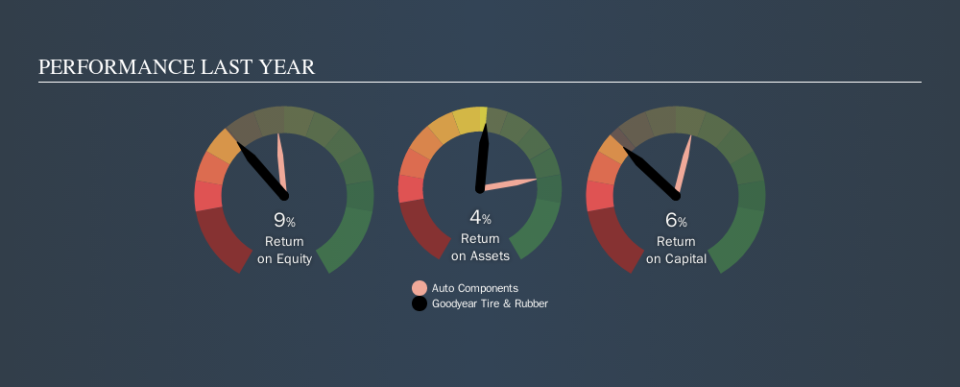Should The Goodyear Tire & Rubber Company’s (NASDAQ:GT) Weak Investment Returns Worry You?

Today we'll evaluate The Goodyear Tire & Rubber Company (NASDAQ:GT) to determine whether it could have potential as an investment idea. Specifically, we're going to calculate its Return On Capital Employed (ROCE), in the hopes of getting some insight into the business.
Firstly, we'll go over how we calculate ROCE. Second, we'll look at its ROCE compared to similar companies. Then we'll determine how its current liabilities are affecting its ROCE.
What is Return On Capital Employed (ROCE)?
ROCE is a metric for evaluating how much pre-tax income (in percentage terms) a company earns on the capital invested in its business. In general, businesses with a higher ROCE are usually better quality. Ultimately, it is a useful but imperfect metric. Renowned investment researcher Michael Mauboussin has suggested that a high ROCE can indicate that 'one dollar invested in the company generates value of more than one dollar'.
How Do You Calculate Return On Capital Employed?
The formula for calculating the return on capital employed is:
Return on Capital Employed = Earnings Before Interest and Tax (EBIT) ÷ (Total Assets - Current Liabilities)
Or for Goodyear Tire & Rubber:
0.064 = US$851m ÷ (US$18b - US$5.1b) (Based on the trailing twelve months to June 2019.)
So, Goodyear Tire & Rubber has an ROCE of 6.4%.
Check out our latest analysis for Goodyear Tire & Rubber
Does Goodyear Tire & Rubber Have A Good ROCE?
When making comparisons between similar businesses, investors may find ROCE useful. In this analysis, Goodyear Tire & Rubber's ROCE appears meaningfully below the 15% average reported by the Auto Components industry. This could be seen as a negative, as it suggests some competitors may be employing their capital more efficiently. Setting aside the industry comparison for now, Goodyear Tire & Rubber's ROCE is mediocre in absolute terms, considering the risk of investing in stocks versus the safety of a bank account. It is possible that there are more rewarding investments out there.
Goodyear Tire & Rubber's current ROCE of 6.4% is lower than 3 years ago, when the company reported a 14% ROCE. Therefore we wonder if the company is facing new headwinds. You can click on the image below to see (in greater detail) how Goodyear Tire & Rubber's past growth compares to other companies.
It is important to remember that ROCE shows past performance, and is not necessarily predictive. Companies in cyclical industries can be difficult to understand using ROCE, as returns typically look high during boom times, and low during busts. ROCE is, after all, simply a snap shot of a single year. What happens in the future is pretty important for investors, so we have prepared a free report on analyst forecasts for Goodyear Tire & Rubber.
How Goodyear Tire & Rubber's Current Liabilities Impact Its ROCE
Short term (or current) liabilities, are things like supplier invoices, overdrafts, or tax bills that need to be paid within 12 months. Due to the way ROCE is calculated, a high level of current liabilities makes a company look as though it has less capital employed, and thus can (sometimes unfairly) boost the ROCE. To counter this, investors can check if a company has high current liabilities relative to total assets.
Goodyear Tire & Rubber has total liabilities of US$5.1b and total assets of US$18b. Therefore its current liabilities are equivalent to approximately 28% of its total assets. This is a modest level of current liabilities, which would only have a small effect on ROCE.
The Bottom Line On Goodyear Tire & Rubber's ROCE
If Goodyear Tire & Rubber continues to earn an uninspiring ROCE, there may be better places to invest. But note: make sure you look for a great company, not just the first idea you come across. So take a peek at this free list of interesting companies with strong recent earnings growth (and a P/E ratio below 20).
I will like Goodyear Tire & Rubber better if I see some big insider buys. While we wait, check out this free list of growing companies with considerable, recent, insider buying.
We aim to bring you long-term focused research analysis driven by fundamental data. Note that our analysis may not factor in the latest price-sensitive company announcements or qualitative material.
If you spot an error that warrants correction, please contact the editor at editorial-team@simplywallst.com. This article by Simply Wall St is general in nature. It does not constitute a recommendation to buy or sell any stock, and does not take account of your objectives, or your financial situation. Simply Wall St has no position in the stocks mentioned. Thank you for reading.

 Yahoo Finance
Yahoo Finance 
